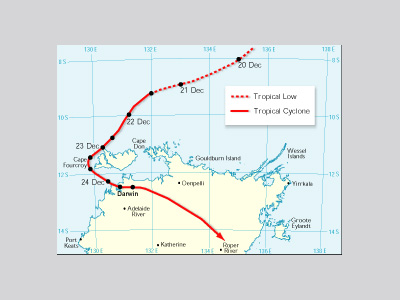Cyclone Tracy of 1974
Devastation in Darwin
Location, Type of Disaster, and Date:
Description:
Tracy was a small tropical cyclone in the northern territory of Australia. This cyclone made land on December 24th, 1974 after 10 pm. Cyclone Tracy developed from a tropical low in the Arafura sea (Hurricane Science 2020). Cyclone Tracy delivered a massive blow to Darwin, leaving 80% of the city in loss and killing 66 people (National Museum of Australia 2024). Wind gusts from Tracy reached up to 217 km/h before the anemometer was destroyed (National Museum of Australia 2024). Tracy left the physical environment in shambles, uprooting every single tree in the town (Hurricane Science 2020). There were no adequate building laws before Cyclone Tracy, leaving 6% of the houses in Darwin still considered immediately habitable after the cyclone (National Climate Change Adaptation Research Facility 2010). The estimated cost of destruction was between $400-500 million dollars in 1974 (equal to $2-4 billion in today's USD) (National Climate Change Adaptation Research Facility 2010). Sea levels in the environment also changed drastically. The sea levels in Darwin’s harbor rose 1.6 meters (Tim's Severe Weather Queensland). Both the human environment and the physical environment were affected by the cyclone. Without Cyclone Tracy hitting Darwin, Australia would not have been able to see the building code violations or have learned the lessons about construction and preparation for cyclones. Cyclone Tracy led to the Darwin Reconstruction Act 1975, to help coordinate and undertake the rebuilding of Darwin (National Archives of Australia). Darwin has since rebuilt and repaired more than 2500 homes.
Figure 2. A image of the suburbs of Darwin post Cyclone Tracy. This image displays to true destruction of the storm aligning to the 6% of houses remaining. https://www.nma.gov.au/defining-moments/resources/cyclone-tracy
Figure 3. Showing the path of the cyclone, building in the Arafura sea before making landfall on Darwin, Australia. https://hurricanescience.org/history/storms/1970s/tracy/index.html
Implications and Consequences:To start, to mitigate the impact of Cyclone Tracy would have been to change the building codes of buildings in the town. Similar to the discussion section, there were no true adequate building laws before the cyclone, leaving the town in despair (National Climate Change Adaptation Research Facility 2010). Consequences of not having building codes prior to the event, led to 6% of the houses able to be habitable after the cyclone (National Climate Change Adaptation Research Facility 2010). From the same idea of housing, destruction costs were between $400-500 million dollars (National Climate Change Adaptation Research Facility 2010). With no thought of a cyclone every hitting Darwin, there was not implications put fourth in the town towards such a severe natural hazard. With the cyclone also hitting on Christmas Eve, there was also implications of a large amount of the population being present in the town. This directly correlates to the amount of deaths and injuries in the total amount of the population of Darwin. There was 66 deaths, 145 people seriously injured, and 500 people with minor injuries (National Museum Australia 2024). Another action that took place, but did not provide enough time was alarms. Alarms for Cyclone Tracy went off at the army base in the town, but there was not enough warning for families to hear the alarm (The Consequences of Large-Scale Evacuation Following Disaster: The Darwin, Australia Cyclone Disaster of December 25th, 1974, 1976). With the implications put in place today, Darwin is more informed on future disaster that could occur at anytime.
https://www.nma.gov.au/defining-moments/resources/cyclone-tracy
https://hurricanescience.org/history/storms/1970s/tracy/index.html
https://www.aidr.org.au/media/1927/cyclone-tracey-key-findings.pdf
https://timsweather.au/cyclone-tracy/
https://www.naa.gov.au/help-your-research/fact-sheets/cyclone-tracy-darwin
https://www.nma.gov.au/defining-moments/resources/cyclone-tracy#:~:text=Cyclone%20Tracy%2C%20which%20hit%20Darwin,traumatised%20population%20left%20the%20city.
https://hazards.colorado.edu/uploads/workingpaper/wp27.pdf



No comments:
Post a Comment
Note: Only a member of this blog may post a comment.